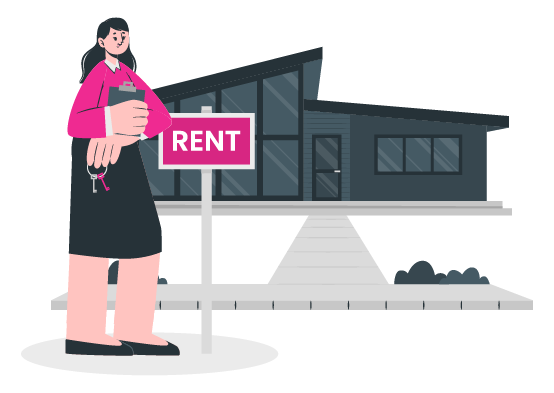Sub-letting in Dublin, Cork, and Galway has become an increasingly popular option for tenants looking to offset rent costs or accommodate temporary absences. Whether you’re a tenant considering sub-letting or a landlord evaluating the implications, understanding the process and legalities is crucial. In this guide, we break down everything you need to know about sub-letting in Ireland, including legal considerations, finding sub-tenants, and best practices to ensure a smooth experience. Platforms like FindQo.ie can help you find and list such properties across areas like Dublin, Galway and Cork.
What is Sub-Letting?
Sub-letting refers to the practice of a tenant renting out all or part of their rented property to another person (the sub-tenant) while maintaining responsibility for the lease agreement with the landlord. This arrangement can be beneficial, but it also comes with legal requirements and potential risks.
Is Sub-Letting Legal in Ireland?
One of the most common questions is: Is sub-letting legal in Ireland? The answer depends on your lease agreement and whether your landlord has granted permission. Under Irish rental laws, a tenant can only sublet with the explicit approval of their landlord. If sub-letting without permission, tenants risk eviction or legal disputes.
Sub-Letting Rules in Ireland
- Tenants must obtain written consent from their landlord before sub-letting.
- The original tenant remains responsible for rent payments and property maintenance.
- Sub-letting agreements should be legally documented to outline the terms and responsibilities of both parties.
- A sub-tenant has fewer legal rights than a direct tenant, making it essential to clearly define expectations.
How to Sublet a Property in Ireland
If you are considering sub-letting in Dublin, Cork, or Galway, follow these essential steps:
- Review Your Lease Agreement: Check if sub-letting is permitted and discuss it with your landlord.
- Get Written Permission: Secure approval in writing to avoid potential legal issues.
- Draft a Sub-Letting Agreement: Define the rental amount, duration, house rules, and payment terms.
- Find a Reliable Sub-Tenant: Screen candidates carefully to ensure reliability and compatibility.
- Notify Utility Providers: Clarify responsibility for utilities and other bills.
- Monitor the Sub-Tenant: Conduct regular check-ins to ensure compliance with the agreement.
Best Cities for Sub-Letting in Ireland
Sub-Letting in Dublin
Dublin, with its high rental prices, sees significant demand for sub-letting. Popular areas include Rathmines, Smithfield, and Phibsborough, where students and professionals seek affordable living arrangements.
Sub-Letting in Cork
Cork’s growing student population and tech industry expansion make it a prime location for sub-letting. Areas like Douglas and Bishopstown offer great opportunities for those looking to rent out rooms temporarily.
Sub-Letting in Galway
With a vibrant student community and seasonal workers, Galway offers strong sub-letting potential. Eyre Square and Salthill are particularly sought after by renters.
Finding the Right Sub-Tenant
To find a sub-tenant in Dublin, Cork, or Galway, consider the following platforms:
- FindQo.ie – A trusted platform for connecting tenants and landlords in Ireland.
- Facebook Marketplace & Groups – Local rental groups often have active members looking for short-term housing.
Sub-Letting vs Short-Term Rentals in Ireland
While sub-letting involves transferring lease rights temporarily, short-term rentals (e.g., Airbnb) cater to tourists and temporary visitors. Before opting for either, check local regulations, as some areas restrict short-term lets.
Landlord Approval for Sub-Letting in Ireland
Many landlords hesitate to approve sub-letting due to concerns about tenant reliability and property care. To improve your chances of gaining approval:
- Propose a responsible sub-tenant with references.
- Offer to include the landlord in the sub-letting agreement.
- Provide assurance that the rent will be paid on time.
Sub-Letting Laws for Renters in Cork and Galway
Each city may have specific rental conditions. For example:
- Cork: Some landlords require additional deposits for sub-letting agreements.
- Galway: Short-term sub-letting is common, but long-term sub-letting may need formal landlord approval.
Steps to Safely Sublet Your Home in Ireland
- Screen Potential Tenants Carefully – Check references and rental history.
- Set Clear Terms – Define the rental period, payment method, and house rules.
- Ensure Legal Compliance – Follow Irish rental laws and obtain necessary permissions.
- Keep Communication Open – Maintain transparency with your landlord and sub-tenant.

Sub-letting in Dublin, Cork, and Galway can be a great way to manage rental costs, but it requires careful planning and adherence to Irish rental laws. If you’re considering sub-letting, always secure landlord approval, draft a proper agreement, and find a responsible sub-tenant. For hassle-free sub-letting opportunities, visit FindQo.ie to explore listings and connect with potential sub-tenants.
By following these guidelines, tenants and landlords alike can navigate sub-letting successfully while ensuring a positive rental experience.

